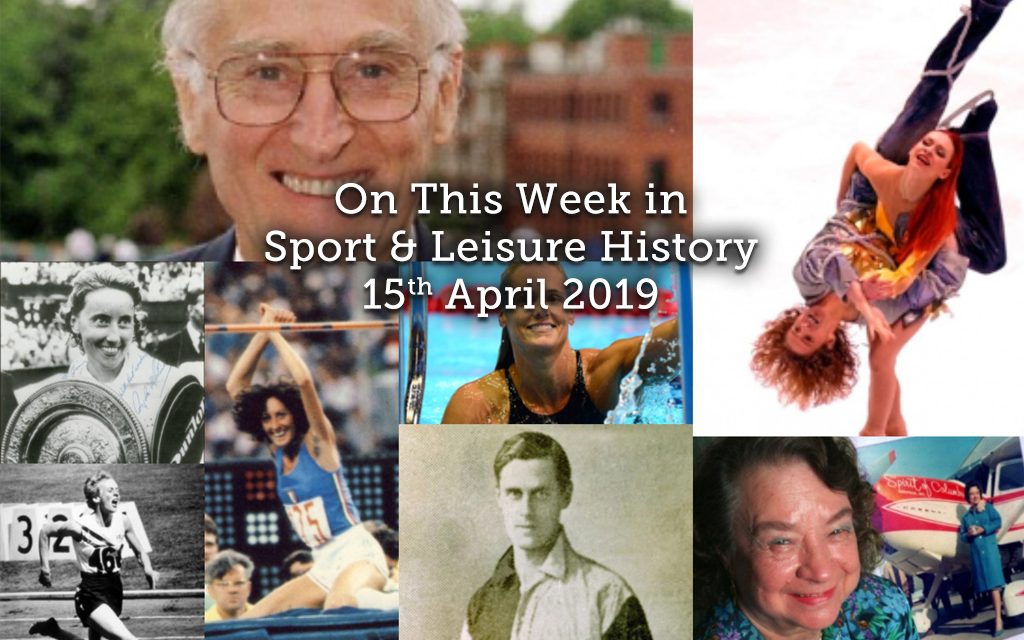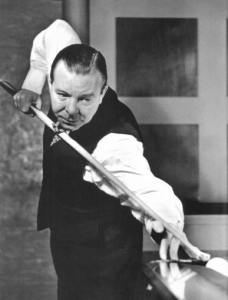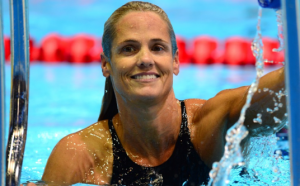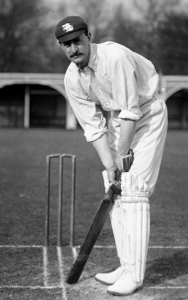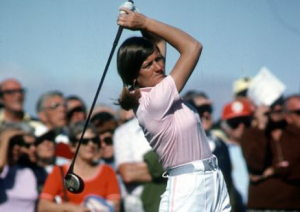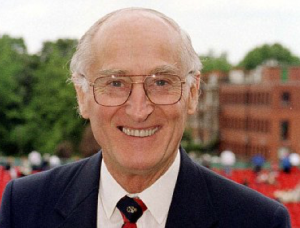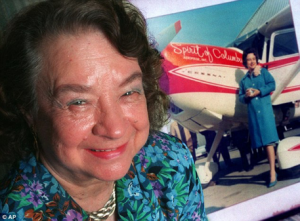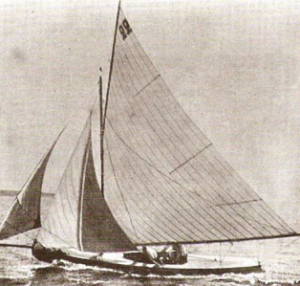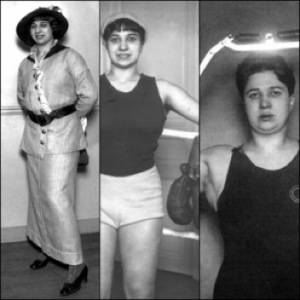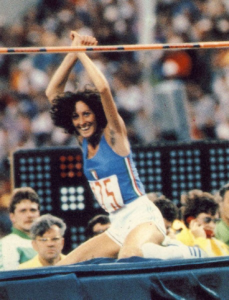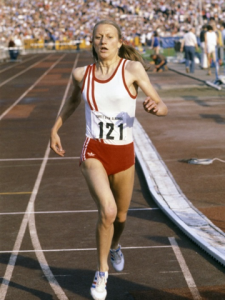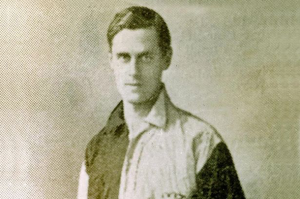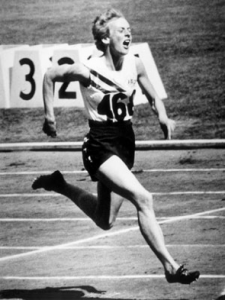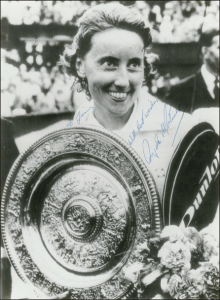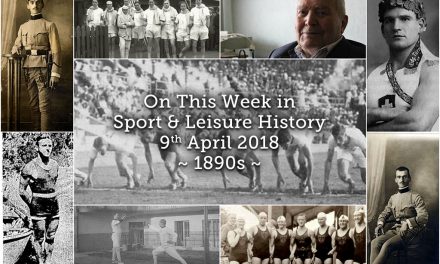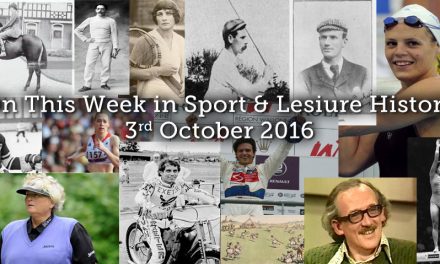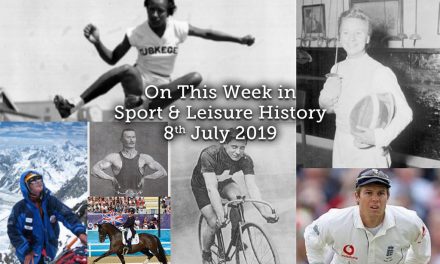15th
- Today in 1896 the first modern Olympic Games came to a close in Athens, Greece.
- On this day in 1912 the British passenger liner RMS Titanic sank in the North Atlantic at 2:20 a.m., two hours and forty minutes after hitting an iceberg. Only 710 of 2,227 passengers and crew on board survive.
- Snooker and Billiards player Joe Davis was born in1901. The first to master the art of controlling the cue ball, he transformed snooker form a simple game of potting to one requiring great skill. He won the first world title in 1927 and went on to win it another 14 times before retiring from the championship in 1946; it is said he never lost a snooker match over level terms during his career. He also won the world professional billiards title four times. Joe died in 1978, a few months after collapsing while watching brother Fred’s epic snooker world championship semi-final against South Africa’s Perrie Mans.
- Sir George Adrian Hayhurst Cadbury (AKA Adrian Cadbury) was born in 1929, a British Olympic rower and Chairman of Cadbury and Cadbury Schweppes for 24 years. Born as a member of the Cadbury family, known for their Quaker philosophy and the chocolate conglomerate which they founded, he was educated at Eton and King’s College, Cambridge. At Cambridge, he rowed in the losing Cambridge boat in the 1952 Boat Race. He also rowed in the Great Britain coxless-four in the 1952 Olympics in Helsinki. Cadbury was a Steward of Henley Royal Regatta and the President of Birmingham Rowing Club.
- In 1947 Jackie Robinson debuts for the Brooklyn Dodgers, breaking baseball’s colour line. The colour line in American baseball, until the late 1940s, excluded, with some big exceptions in the 19th century until the line was firmly drawn, players of Black African descent from Major League Baseball and its affiliated Minor Leagues. Racial segregation in professional baseball was sometimes called a gentlemen’s agreement, meaning a tacit understanding, as there was no written policy at the highest level of organized baseball, the major leagues. But a high minor league’s vote in 1887 against allowing new contracts with black players within its league sent a powerful signal that eventually led to the disappearance of blacks from the sport’s other minor leagues later that century, including the low minors. After the line was in virtually full effect in the early 20th century, many black baseball clubs were established, especially during the 1920s to 1940s when there were several ‘Negro Leagues’. During this period some light-skinned Hispanic players, Native Americans, and native Hawaiians were able to play in the Major Leagues. . In 1947, both Robinson in the National League and Larry Doby with the American League Cleveland Indians appeared in games for their teams. By the late 1950s, the percentage of black players on Major League teams matched or exceeded that of the general population.
- In 1964 George Best made his debut for Northern Ireland, and helped them to a 3-2 win over Wales at Swansea. It was the first of 37 caps for the Ulsterman, who score nine goals for his country.
- On this day in 1965 the NFL changes the penalty flag from white to bright gold.
- Dara Torres was born in 1967, an American swimmer who is a twelve-time Olympic medallist and former world record-holder in three events. Torres is the first swimmer to represent the United States in five Olympic Games (1984, 1988, 1992, 2000 and 2008), and, at age 41, the oldest swimmer to earn a place on the US Olympic team. At the 2008 Olympics, she competed in the 50m freestyle, 4×100m medley relay, and 4×100m freestyle relay, and won silver medals in all three events. Torres has won twelve Olympic medals (four gold, four silver, four bronze), one of three women with the most Olympic women’s swimming medals. The others are fellow Americans Jenny Thompson and Natalie Coughlin. Torres won five medals at the 2000 Olympics when, at age 33, she was the oldest member of the 2000 US Olympic Swim Team. She has also won at least one medal in each of the five Olympics in which she has competed, making her one of only a handful of Olympians to earn medals in five different Games.
- Viv Richards scored a century off just 56 balls against England at St John’s in 1986.
- This date in 1989 turned into the blackest day in British sporting history when 96 football fans lost their lives in the Hillsborough Disaster shortly after the start of the FA Cup semi-final between Liverpool and Nottingham Forest.
- At the 100th edition of the Boston Marathon in 1996: Moses Tanui of Kenya was the first man home in 2:09:15 and Uta Pippig of Germany the first women to cross the finish line in 2:27:12.
- Australian swimmer, actor and sporting commentator Murray Rose died at the age of 73 today in 2015. He was a six-time Olympic medallist (four gold, one silver, one bronze), and at one time held the world records in the 400m, 800m, and 1500m freestyle (long course). He made his Olympic debut at the 1956 Olympics as a 17-year-old and won three Olympic medals, all gold. Four years later, as a 21-year-old, he won three Olympic medals (one gold, one silver, one bronze) at the 1960 Olympics. Rose was born on 6 January 1939 in Birmingham, England. As World War II broke out, his family moved to Australia in 1940. He started swimming as a boy and attended Cranbrook School in Bellevue Hill, Sydney. He swam regularly at Redleaf Pool, an enclosed saltwater swimming pool in the suburb of Double Bay. In 2012, the pool was renamed Murray Rose Pool in his honour.
- Emma Martina Luigia Morano died on this day in 2017. Born on 29 November 1899 shewas an Italian supercentenarian who, before her death at the age of 117 years and 137 days, was the world’s oldest living person whose age had been verified, and the last living person to have been verified as being born in the 1800s. She remains the oldest Italian person ever and the second-oldest European person ever behind Frenchwoman Jeanne Calment.
- Joe Davis
- Dara Torres
16th
- Reginald Erskine Foster, nicknamed Tip Foster, commonly designated RE Foster in sporting literature was born today in 1878. He was an English cricketer and football player, the only man to have captained England at both sports. One of seven Foster brothers who were all educated at Malvern College and who all played cricket for Malvern and for Worcestershire; Foster was a right-handed middle-order batsman. In 1903 he scored 287 on Test debut, setting a world record for the highest Test score. He first played for Oxford University Cricket Club in 1897; in addition to cricket, he also represented Oxford at football, racquets and golf. However, although he did fairly well, it was not until 1899 that his beautiful and immaculate driving to the off-side made him into one of the finest batsmen of his time. He had played for Worcestershire while they were still a minor county but in 1899, their inaugural season as a first-class county, he and his brother Wilfrid Foster both scored two hundreds in a match (against Hampshire), a feat which remains unique in county cricket. In 1900, as captain of Oxford, he scored 171 to set the record for the highest individual score in the Varsity Match, and he scored 102 not out and 136 for the Gentlemen against the Players at Lord’s, the first man to score two centuries in a match in the Gentleman v Players series. In total, Foster scored 930 runs at an average of 77.5 for Oxford in the 1900 season,]a record in University cricket. For these performances, Foster was named a Wisden Cricketer of the Year in 1901 and the following year a superb run of form for Worcestershire resulted in him scoring 1,957 runs, at an average of 54.36. However, business prevented him representing the MCC in Australia the following year and England undoubtedly missed his brilliant batting. Moreover, apart from one match against Warwickshire, he could devote no time to first-class cricket in May and June 1902, ruling him out of contention for an England place against Australia. In football, Foster played as a forward for the Corinthians in the early 1900s. He also played for Old Malvernians, a team made up of ex pupils from Malvern College. He played five matches for England between 1900 and 1902, making his debut against Wales on 26 March 1900. In his second game, against Ireland at the Dell, Southampton, he scored his first international goal in a 3-0 victory.]C. B. Fry played at full-back in the same game. Foster was awarded the captaincy against Wales in his final appearance on 3 March 1902, which ended in a 0-0 draw. During his short England career he scored two goals.
- Another English cricketer, Fred Root, was born today in 1890. He played for England in 1926 and for Derbyshire between 1910 and 1920 and for Worcestershire between 1921 and 1932. Born in Somercotes, Derbyshire he initially served on ground staff of Leicestershire before beginning his first-class career for Derbyshire, making his debut in the 1910 season. He played for five seasons for Derbyshire before cricket was suspended in England because of World War I, doing very little apart from a couple of promising performances in 1913. During the war, Root was hit in the chest while serving as a dispatch rider, but recovered and resumed his cricketing career after the war. Root moved to Worcestershire in 1921 after two seasons in league cricket. After a season and a half when he failed to establish himself as an orthodox right-arm fast medium bowler. He became an exponent of the leg theory style of bowling, and achieved great success with it. His ability to swing the ball in and make it gain pace off the ground made him very difficult on anything like a fiery pitch, whilst his powerful physique and consequent stamina made Root respected even on pitches giving bowlers no assistance. In 1923 he took 170 wickets for 20.53 each and 153 for less than 17 each in 1924, but spoilt his chances of going on that winter’s Ashes tour with a poor performance for the Players at the Oval on a pitch that should have suited him. Although Worcestershire were entering a period where they were the weakest of the County teams, Root’s tireless, accurate and lively bowling only improved. In 1925 he took a record 207 wickets for the county, almost half of Worcestershire’s wickets in first class matches. During the late 1920s, Root was effectively the team’s only penetrative bowler. In 1926 Root took 7 for 42 against the Australians on a pitch so dead as to be quite unsuited to him. Though he was less effective than previously in county cricket (soft pitches may have played a part), Root played three Test matches for England against Australia that year. Unusually he was unable to bat in any of the three tests, due to rain interruptions and the depth of the England batting. Root still holds the record for the most Test Matches in a career without ever batting. Root also stood as an umpire in 35 first-class matches between 1947 and 1949.
- Today in 1910, the oldest existing indoor ice hockey arena still used for the sport in the 21st century, Boston Arena, opens for the first time.
- Today in 1912 the American aviator Harriett Quimby became the first woman to fly an airplane across the English Channel. In 1911, she was awarded a U.S. pilot’s certificate by the Aero Club of America, becoming the first woman to gain a pilot’s license in the United States. Quimby took off from Dover en route to Calais and made the flight in 59 minutes, landing about 25 miles (40km) from Calais on a beach in Équihen-Plage, Pas-de-Calais. Her accomplishment received little media attention, however, as the sinking of the RMS Titanic the day before consumed the interest of the public and filled newspapers. Although Quimby lived only to the age of thirty-seven, dying in an airplane accident later in the same year as her historic flight, she had a major influence upon the role of women in aviation.
- Russian athlete Vera Krepkina (later Kalashnikova) was born in 1933. She competed for the Soviet Union at the 1952, 1956 and 1960 Olympics. At all these Olympics she finished fourth in the 4x100m relay but eliminated in the heats of the 100m. In 1960 she also took part in the long jump and won a surprise gold medal with an Olympic record of 6.37 m, ahead of the defending champion Elżbieta Krzesińska and the world record holder Hildrun Claus. At the European Championships she won gold medals in the 4x100m relay in 1954 and 1958 and finished second in the 100m in 1958. She was a member of the Soviet team that set a world record in the 4x100m relay in 1956, and she tied the world record (11.3 seconds) for 100m in 1958. During her career Krepkina won eight Soviet titles: 100m in 1952, 1957 and 1958; 200m in 1952; 4x100m relay in 1952, 1960 and 1965; and 4×200 m relay in 1952. In retirement she worked as a children’s athletics coach in Ukraine.
- One of the best-known names in professional basketball, Kareem Abdul-Jabbar, was born in 1947. Christened Lew Alcindor, he changed his name after converting to Islamic faith in 1969. He played in a record 1560 National Basketball Association (NBA) games in a career that spanned 20 years, from 1970 to 1989, with a tally of 38,387 points and 15,837 field goals.
- Alison Ramsay, former Scottish field hockey player was born in 1959. She was a member of the Great Britain and Northern Ireland squad that won bronze at the 1992 Olympics in Barcelona. She is one of the world’s most capped women’s hockey players, with over 250 appearances for Scotland and Great Britain and Northern Ireland, and received the MBE. Ramsay enjoyed a thirteen-year international career before her retirement in 1995, after which she played for Bonagrass Grove at club level and worked as a solicitor. Ramsay received the prestigious MacRobert Thistle Award in 1995 for her achievements and she remains one of the most respected hockey players to have come out of Scotland.
- Today in 1972, Jane Blalock wins the 1st Colgate Dinah Shore Golf Championship.
- On this day in 1980, Arthur Ashe formally retired from professional tennis.
- On this day in 2007, at the age of 92, the Brazilian swimmer Maria Lenk passed away, who to this date is still considered as one of the greatest Brazilian female athletes. At the age of 17, she was the first Brazilian and South-American woman to participate in the Summer Olympic Games, at the 1932 Olympics, in Los Angeles. Lenk was the first Brazilian in history to set a world record in swimming. On November 8, 1939, in Rio de Janeiro with a time of 2:56.0, she beat Jopie Waalberg’s previous record of 2:56.9, for 200m breaststroke This record lasted almost 5 years, until Nel van Vliet, from the Netherlands broke it on August 17, 1946, with a time of 2:52.6. In the same year, she also broke the world record for the discontinued category of 400m breaststroke, with a time of 6:15.8. She also participated in the 1936 Olympics, in Berlin, where she reached the semi-finals of the 200m breaststroke. on this occasion, she also became the first woman in the world to swim Butterfly in an official competition. At the time, Butterfly was used as a form of swimming Breaststroke, and not yet recognized as a separate swimming stroke. Lenk’s account of the event was that at the time she subscribed to a German magazine that ran a story on David Armbruster’s and Jack Sieg’s work in developing “a new way of swimming the Breaststroke”. She became interested and started practicing the stroke by herself in training. In 1936, she and Jack Sieg were the only two people that were prepared to use the technique in the Breaststroke races at the Summer Olympics. Lenk’s goal of winning an Olympic medal was cut short when World War II caused the cancellation of the Games of 1940 and 1944, which would have corresponded to her peak in competitive swimming. She retired in 1942, but never stopped swimming, focusing on Masters events. On April 16, 2007, she was training in the Clube de Regatas do Flamengo’s swimming pool when her blood pressure dropped and she suffered a sudden respiratory arrest. She was taken to Copa D’Or Hospital, in Copacabana, but couldn’t be revived and she died of cardiac arrest. Before her death, Maria Lenk still swam 1½ km every day, even in her 90s.
- Pentti Alexander Lund, (December 6, 1925 – April 16, 2013) Finnish Canadian professional ice hockey right winger who played for the Boston Bruins and New York Rangers in the National Hockey League, died today in 2013. He was often credited as being the first Finnish player in the National Hockey League, Albert Pudas, however, played 4 games with the Toronto Maple Leafs in 1926-1927.
- Tip Foster
- Jane Blalock
17th
- The Greek tennis player Demetrios Petrokokkinos was born today in 1878. He competed at the 1896 Olympics, he was defeated in the first round of the singles tournament by fellow Greek Evangelos Rallis. This put him in a six-way tie for eighth (last) place among the thirteen man field. In the doubles tournament, Petrokokkinos again faced Rallis in the first round. This time, Petrokokkinos and his partner Dionysios Kasdaglis of Egypt defeated Rallis and his partner Konstantinos Paspatis. Petrokokkinos and Kasdaglis faced Edwin Flack of Australia and George S. Robertson of Great Britain in the semi-finals, again winning the match to advance to the final. There, they met Irishman John Pius Boland and German Friedrich Traun, to whom they lost to place second.
- Carl Heinrich Goßler, German Olympic rower was born in 1885. He competed in the 1900 Olympics where he was the coxswain of the German boat Germania Ruder Club, Hamburg, which won the gold medal in the coxed fours final B. He was killed in action during World War I.
- Former British tennis player, TV commentator and author, John Barrett, was born on this day in 1931. His father Alfred had the rare distinction of having played both for Leicester Tigers RFC as a wing three-quarter and for Leicester Fosse FC (the former Leicester City) as a wing half. John went on to compete at Wimbledon for eighteen years from 1951, reaching the third round of the singles on four occasions and the quarter-finals of the mixed doubles three times. At his peak he was ranked as his country’s fifth best singles player. His doubles successes included the capture of the 1953 National Covered Court title with Don Black of Rhodesia and the 1956 Asian Doubles with Roger Becker. In 1956 he became a Davis Cup player and was appointed captain of the British Davis Cup team for the years 1959-1962. Three years later he established and ran the LTA Training Squad, known as “The Barrett Boys” which set new standards of fitness in British tennis between 1965 and 1968. His broadcasting career with BBC Television began in 1971 and he followed Dan Maskell as the BBC’s ‘Voice of Wimbledon’ until his retirement following Wimbledon in 2006. He also commentated for Channel 9, Australia (1980-1986) and for Channel Seven, Australia (1987 – 2007) and at various times for HBO, ESPN, and the USA Networks in America, CTV in Canada and both ATV and TVB in Hong Kong. In 2007 he was awarded the MBE for Services to Sports Broadcasting. For fourteen years (1997-2001) he served as President of The Dan Maskell Trust, a charitable organisation established in 1997 to help people with disabilities to play tennis. A member of the International Lawn Tennis Club of Great Britain since 1953, he served as Chairman from 1983-1994, as President from 2004-2008 and is currently a Vice-President. A member of the All England Lawn Tennis and Croquet Club since 1955 and currently a Vice-President, he served for twelve years on the Club Committee and the Committee of Management of The Championships, during which time he started to compile a complete database of every result that has ever occurred at Wimbledon, in all events. This mammoth task took some 20 years to complete and can now be accessed on the Club’s web site. In April 1967 he married the former French, Australian and Wimbledon champion Angela Mortimer and they have a son, a daughter and four grandchildren. In 2014 Barrett was inducted into the International Tennis Hall of Fame.
- On this day in 1939 Joe Louis knocks out Jack Rope in the first round to win the heavyweight boxing title.
- Yachtswoman Clare Francis was born in 1946. In 1976 she made the fastest crossing of the Atlantic by a woman. Competing in the Observer single-handed race, she made the crossing in 29 days.
- Finnish middle-distance athlete Pekka Antero Vasala was born in 1948. He won an Olympic gold in the 1972 Games in Munich. In the 1968 Olympics in Mexico City he failed to advance from the first round of heats in the 1500m. His later success is partly attributed to his legendary hill training of which he said “[it] is suicidal for other runners to copy my hill sessions without adequate background“. In Munich he won the 1500m in a time of 3:36.3secs, ahead of the legendary Kip Keino and Rod Dixon. This marked a memorable day for Finnish athletics because his countryman Lasse Virén won the 5000m earlier in the day, in addition to winning the 10,000m in world record time earlier in the games. With a medal in every track event from 1500 to 10,000m, three gold and a bronze (Tapio Kantanen in the 3000m steeplechase) Finnish athletes achieved a level of success not seen since the era of the “Flying Finns” (1912–1936).His nephew, Samuli Vasala, also an athlete, won the 2003 Nordic Cross Country Championships. Vasala is the son-in-law of Martti Matilainen.
- The Peak District became the United Kingdom’s first National Park on this day in 1951.
- Jerrie Mock, a relatively untested pilot, accomplished on this day in 1964 what Amelia Earhart could not, becoming the first woman to fly solo around the world. When she took off on March 19, 1964, from Columbus, Ohio, Mrs. Mock was a 38-year-old housewife and recreational pilot who had logged a meagre 750 hours of flight time. She returned there on April 17 — 29 days, 11 hours and 59 minutes later — after a 23,000-mile journey over the Atlantic, the Mediterranean, the Red Sea, the Gulf of Oman, the Arabian Sea and the Pacific, with stops in the Azores, Casablanca, Cairo, Karachi, Calcutta, Bangkok and Honolulu, among other places. She navigated 1,300 miles over the Pacific from Guam to tiny Wake Island, three miles in diameter, without the benefit of ground signals. Between Bangkok and Manila, she flew over embattled Vietnam. “Somewhere not far away a war was being fought,” she wrote later, “but from the sky above, all looked peaceful.” Mrs. Mock and her husband, Russell, were half-owners of the plane, an 11-year-old single-engine Cessna 180 named the Spirit of Columbus (evoking the Spirit of St. Louis, the plane Charles Lindbergh flew in becoming the first to cross the Atlantic solo 37 years earlier).The Mocks’ plane had been modified for the journey. Three of its four seats had been removed and fuel tanks were installed in their place. That summer Flying magazine asked Mrs. Mock why she had undertaken such a treacherous journey alone. “It was about time a woman did it,” she said. Mrs. Mock’s feat has largely been overlooked in popular history; she is not an inductee of the National Aviation Hall of Fame, in Dayton, Ohio. But she was celebrated at the time. The Columbus Evening Dispatch, her home-town paper and one of the trip’s sponsors, splashed her return across the front page with the headline “Jerrie Does It; Sets Global Air Mark.”
- On this day in 1966 the 100th international football match between Netherlands and Belgium took place in Rotterdam. The Netherland were the 3-1 winners.
- Neil Thomas became the first Briton to win a medal in the World Gymnastics Championships when he took silver in the floor exercises of the tournament in 1993, held at the National Exhibition Centre in Birmingham. On this day in 2011 Emmanuel Matai set a new course record when winning the London Marathon at his fourth attempt, his winning time being 2:04:40.
- Today in 2015 James Anderson became the highest wicket-taking bowler in England’s test cricket history.
- John Barrett
- Jerrie Mock
18th
- On this day in 1809 the first running of the 2000 Guineas took place at Newmarket.
- Linton Hope (born Hopps), a British sailor who was born on this day 1863, in Macclesfield, Cheshire represented Great Britain at the 1900 Olympics in Meulan, France. With Lorne Currie as helmsman and fellow crewmembers John Gretton and Algernon Maudslay, Hope took first places in both the 0.5 to 1 ton class and the Open class. Hope designed a variety of yachts, as well as the Fairy One Design for the North of Ireland Yacht Club, international canoes and Thames Raters. Both Olympic races were won using the yacht Scotia designed by Hope. He was appointed naval architect to the King of the Belgians. In 1915 Hope designed the AD Flying Boat for the British Admiralty’s Air Department and his hull designs were used by a number of British flying boats in the 1920s including the Phoenix P.5 Cork and Fairey Titania, largest flying boat in the world at the time.
- Violette Morris, French athlete who won two golds and a silver at the Women’s World Games in 1921–1922 was born today in 1893. She served in World War I as a military nurse during the Battle of the Somme and a courier during the Battle of Verdun. Morris was a gifted athlete, becoming the first French woman to excel at shot put and discus, and playing on two separate women’s football teams. She played for Fémina Sports from 1917 until 1919, and for Olympique de Paris from 1920 to 1926. Both teams were based in Paris. She also played on the French women’s national team. In addition to her football career, she was an active participant in many other sports. She was selected for the French national water polo team even though there was no women’s team at the time. She was an avid boxer, often fighting against, and defeating men. She became French national champion in 1923. Among the other sports she participated in were road bicycle racing, motorcycle racing, car racing, airplane racing, horseback riding, tennis, archery, diving, swimming, weightlifting, and Greco-Roman wrestling. Her most brilliant athletic years were considered to be from 1921 to 1924, when her slogan was “Ce qu’un homme fait, Violette peut le faire!” (Anything a man can do Violette can do!). She later won the 1927 Bol d’Or 24 Hours car race at the wheel of a BNC. She was refused license renewal by the Fédération française sportive féminine (FFSF – French Women’s Athletic Federation) amid complaints of her bisexual lifestyle and was therefore barred from participating in the 1928 Olympics. The agency cited her lack of morals, especially in light of the fact that one of her lovers, Raoul Paoli, made public her bisexuality. Paoli had recently left Morris after she had initially decided to undergo an elective mastectomy in order to fit into racing cars more easily. After 1928, Morris settled into owning a car parts store in Paris, and, along with her employees, building racing cars. At the end of December 1935, Morris was recruited by the Sicherheitsdienst (Security Service), a wing of the infamous SS of Nazi Germany. She was invited, with honour, to attend the 1936 Olympics in Berlin at the personal behest of Adolf Hitler. She gave Germany partial plans of the Maginot Line, detailed plans of strategic points within the city of Paris, and schematics of the French army’s main tank, the Somua S35. Her plans were integral to the German invasion of Paris in 1940. She benefited from the German occupation, often colluding with the local mob. She lived through the German occupation in a houseboat on the River Seine. One of her main responsibilities during the war was to foil the operation of the Special Operations Executive, the British-run organisation that helped the resistance. For these activities, Morris was sentenced to death in absentia and was killed along a country road by members of a French resistance group on 26 April 1944, at the age of 51, while out driving with friends who were also collaborators. Two other passengers were little children. They too were killed. Her body, riddled with bullets, was never claimed, and was buried in a communal grave.
- In 1903 Bury registered the biggest winning margin in FA Cup final history by beating Derby County 6-0 at Crystal Palace.
- Doug Insole, former English cricketer was born in 1926. He played for Cambridge University, Essex and in nine Test matches for England, five of them on the 1956-57 tour of South Africa, where he was vice-captain to Peter May. After retiring from playing, he was prominent in cricket administration, and served as chairman of the England selectors and as President of the MCC.
- Racing driver Jochen Rindt was born in 1942. German-born Rindt was brought up in Austria. In 1970 he became the first and only man to be declared world-champion posthumously.
- West Indian fast bowler Malcolm Marshall was born today in 1958. He is the second West Indian bowler, after Lance Gibbs, to take 300 Test wickets.
- On this day in 1966 Bill Russell agreed to become head coach of the Boston Celtics NBA team, which made Russell the first African American head coach in NBA history. He commented to journalists: “I wasn’t offered the job because I am a Negro, I was offered it because Red figured I could do it.
- Born today in 1990, Anna van der Breggen, Dutch racing cyclist. While participating in the Team Time Trial at the 2014 Road World Championships in Ponferrada, Spain, van der Breggen broke her pelvis in a crash sustained by her Rabo Liv team. However, she recovered to win her first race of 2015, the Omloop Het Nieuwsblad. In 2015, she won a bronze medal in the Road Race at the inaugural European Games, and was awarded won the Gerrit Schulte Trophy for the best Dutch of cyclist of the year. She won gold in the women’s road race at the 2016 Rio Olympics.
- Ioana Ducu, Romanian tennis player, was born on this day in 1996. She has won one doubles title on the ITF tour in her career. On 9 September 2013, she reached her best singles ranking of world number 830. On 3 November 2014, she peaked at world number 736 in the doubles rankings. In June 2014, together with fellow Romanian Ioana Loredana Roșca, Ducu won the girls’ doubles tournament at the French Open, defeating CiCi Bellis and Markéta Vondroušová in three sets in the final
- Bruno Sammartino, October 6, 1935 – April 18, 2018) Italian-born American professional wrestler, best known for his work with the World Wrestling Federation (WWF, now WWE), died at the age of 82 on this day in 2018. He held the WWF World Heavyweight Championship (WWF Heavyweight Championship during his second reign) for more than 11 years (4,040 days) across two reigns, the first of which is the longest single reign in the promotion’s history at 2,803 days. Called “The Italian Strongman” and “The Strongest Man in the World”early in his career, Sammartino earned the title “The Living Legend” during his lifetime. Known for his powerful bearhug finishing move, he is widely regarded as one of the greatest professional wrestlers of all time.
- Linton Hope his Olympic Yacht
- Violette Morris
19th
- Sydney Barnes, English professional cricketer who is generally regarded as one of the greatest ever bowlers, was born in 1873. He was right-handed and bowled at a pace that varied from medium to fast-medium with the ability to make the ball both swing and break from off or leg. Barnes was unusual in that, despite a very long career as a top-class player, he spent little more than two seasons in first-class cricket, representing Warwickshire and Lancashire. Instead, he preferred league and minor counties cricket for mostly professional reasons. He played for several clubs in the Lancashire, North Staffordshire, Bradford and Central Lancashire leagues between 1895 and 1934. In addition, he had two phases playing for Staffordshire in the Minor Counties Championship. In Test cricket, Barnes played for England in 27 matches from 1901 to 1914, taking 189 wickets at 16.43, one of the lowest Test bowling averages ever achieved. In 1911–12, he helped England to win the Ashes when he took 34 wickets in the series against Australia. In 1913–14, his final Test series, he took a world-series record 49 wickets against South Africa. In 1963, Barnes was named by Wisden Cricketers’ Almanack in its hundredth edition as one of its “Six Giants of the Wisden Century”. In 2008, he had the highest rating among bowlers in the ICC Best-Ever Test Championship Ratings and, in 2009, he was inducted into the ICC Cricket Hall of Fame.
- The first Boston Marathon was held in 1897 and won by John J McDermott of New York in 2:55:10. Held every April on Patriot’s Day, it has been run every year since its inauguration and is the world’s oldest annual race of its kind.
- Sara Simeoni, Italian high jumper, who won gold at the 1980 Olympics and twice set a world record in the women’s high jump, was born today in 1953. She soon took up athletics, specialising in the high jump. Her first international result was at the 1971 European Championships in Helsinki, where she ended in 9th with a 1.78m jump. Her first international success was at the 1976 in Montreal, where she won silver, with a personal best of 1.91m, and was beaten only by Rosemarie Ackermann’s 1.93m leap. In August 1978, she set the new world record with 2.01m in Brescia. Later in the same month she equalled it at Prague while winning the European title. In 1980, Simeoni set a new Olympic record of 1.97m, when winning gold in Moscow. Simeoni was the only woman athlete not from a Communist country to win an athletics gold medal in Moscow. At 1984 Olympics, Simeoni carried the Italian flag at the opening ceremony, here, she cemented her reputation as one of the greatest female high jumpers ever, in a thrilling duel with German Ulrike Meyfarth. Simeoni managed to reach 2 meters for the first time since 1978. The ageing Meyfarth, however, replied with a notable 2.02m jump, and Simeoni won a silver medal. Simeoni’s other titles include two bronze medals at the European Championships and 25 national titles. Her jump of 2.01m was the Italian record for women for 29 years. On 8 June 2007, Antonietta Di Martino jumped 2.02m, establishing the new Italian record for women. Sara Simeoni is widely considered one of the best Italian female athletes ever. She is married to her coach Erminio Azzaro. Their son Roberto Azzaro is also a high jumper.
- Test cricket umpire Harold “Dickie” Bird was born in 1933. A former player with Yorkshire and Leicestershire, he made his name as one of the best-known and best-loved umpires.
- The former England footballer Trevor Francis was born in 1954. He joined Birmingham City as a 16-year-old and subsequently transferred to Nottingham Forest, in 1979, becoming Britain’s first £1 million footballer. He enjoyed a spell in Italy before returning to Britain and eventually going into management at Sheffield Wednesday.
- Bobby Charlton played the first of his 106 games for England against Scotland at Hampden Park in 1958. He also scored the first of his record 149 goals in the 4-0 win.
- On this day in 1966, Roberta Louise “Bobbi” Gibb became the first woman to run the entire Boston Marathon. She is recognized by the Boston Athletic Association as the pre-sanctioned era women’s winner in 1966, 1967, and 1968. At the Boston Marathon, the pre-sanctioned era comprised the years from 1966 through 1971, when women ran and finished the race unofficially. In 1996 the BAA retroactively recognized as champions the unofficial women’s leaders of 1966–71. Gibb’s run in 1966 challenged prevalent prejudices and misconceptions about women’s athletic capabilities.
- Today in 1982, Rosie Ruiz, the Cuban American runner who was declared the winner in the female category for the 84th Boston Marathon in 1980, was arrested for forgery. She was charged with embezzling $60,000 from the real estate company which she worked for. Not a stranger to controversy, she was stripped of her 1980 marathon title eight days after the race when it was discovered that she had not run the entire course. She is believed to have jumped onto the course about a half-mile before the finish.
- Today in 1987 The Simpsons first appeared, as a series of shorts, on The Tracey Ullman Show, first starting with Good Night.
- At St Mellion, Cornwall, in 1991, Ian Woosnam missed the cut in the Benson and Hedges International after two opening rounds of 82; a week earlier he had won the US Masters – in the words of the immortal Greavsie, “Funny ‘old game, golf!”
- The Norwegian marathon runner and former world record holder, Grete Waitz née Andersen, died today in 2011. In 1979, she became the first woman in history to run the marathon in under two and a half hours. She won nine New York City Marathons between 1978 and 1988, more than any other runner in history. She won a silver at the 1984 Olympic Games in Los Angeles and gold at the 1983 World Championships in Helsinki. Her other marathon victories included winning the London Marathon in 1983 and 1986. She was also a five-time winner of the World Cross Country Championships.
- Ian McIntyre, (9 December 1931 – 19 April 2014) BBC Radio producer, journalist, broadcaster and author, died today in 2014. He was Controller of BBC Radio 4 from 1976 to 1978 and then Controller of BBC Radio 3 between 1978 and 1987. After joining the BBC in 1957 after National Service, he presented and produced a number of influential current affairs programmes, most notably Analysis and At Home and Abroad. After his retirement from Radio 3 in 1987, he became associate editor of The Times and has written a number of biographical books.
- Sara Simeoni
- Grete Waitz
20th
- Born today in 1860 was French trap shooter Justinien Clary. He competed in the late 19th century and early 20th century, participating in Shooting at the 1900 Summer Olympics in Paris, winning bronze in the trap shooting competition.
- Fellow Frenchmen Roger de Barbarin and Rene Guyot won gold and silver respectively. Clary was born and died in Paris.
- The world’s first motor racing using mechanical power took place at Paris in 1887. Count Jules Philippe de Dion won the 19.3mile (31km) race at an average speed of 37mph (59.5 km/hr) in his De Dion steam quadricycle.
- Harold Godfrey Bache, English cricketer who played 20 first-class matches between 1907 and 1910, 17 of them for Worcestershire, was born in 1889. Bache was also a fine footballer, playing for Corinthian F.C. and West Bromwich Albion and winning an England cap. Bache was educated at King Edward VI School, Birmingham, and Caius College, Cambridge. He made his first-class debut for Worcestershire against Surrey at Worcester late in the 1907 season, scoring 9 in his only innings and holding three catches. The following season he played twice for the county, but he made nine appearances in 1909 and eight in 1910. Mostly he played for Worcestershire but he turned out three times for Cambridge University, but was never awarded a Blue. His top score of 36 was made against Middlesex at Lord’s in 1910. Later in the same season against the same opposition, but this time at Worcester, he took two of his three career wickets: those of Patsy Hendren and Jack Hearne. His other wicket was that of Sussex’s Robert Relf in 1909. Bache played for the elite Corinthian FC 43 times and scored 95 goals. The Corinthians were the first icons of world football and provided Bache the perfect platform to showcase his talents. He scored 7 in the 13-0 victory over Ipswich on New Years Eve in 1910 for example. He excelled whilst on the clubs famous tours and in 1911, took little mercy on his Canadian and American hosts, netting 34 goals in just 18 matches. Bache joined the Lancashire Fusiliers and reached the rank of Second Lieutenant. He was killed in action at Ypres, Belgium at the age of just 26. Having no known grave, he is commemorated on the Menin Gate Memorial.
- On this day in 1920 the 7th modern Olympic Games were opened in Antwerp, Belgium.
- Phill Hill, the first North American to win the world motor-racing drivers’ title, was born in 1927. He won the title in 1961.
- In 1931 the British House of Commons agreed that sport could be played on a Sunday.
- The former Great Britain rugby league coach Maurice Bamford was born in 1936. He had unsuccessful periods at Huddersfield, Wigan and Batley before his talent as a motivator emerged at Halifax. He was snapped up by Leeds and then appointed coach to the national side.
- Elizabeth “Betty” Cuthbert, Australian athlete, and a four times Olympic champion was born in 1938. During her career, she set world records for 60m, 100yds, 200m, 220yds and 440yds. She went to Ermington Public School which inspired and supported her to go in to the Olympics. Cuthbert also a member of the Australian relay teams winning in the 4×100m, 4×110yds, 4×200m and 4×220yds. At the age of 18, prior to the 1956 Olympics in Melbourne, she set a World Record in the 200m, making her one of the favourites for gold in that event. She reached the finals of the 100m, setting an Olympic record of 11.4sec in her heat (also her PB), while the Australian World Record holder Shirley Strickland de la Hunty was eliminated. She won the final which made her the big favourite for the 200m title. She lived up to the expectations, and became the Australian “Golden Girl”. A third gold medal for Cuthbert came when she ran the final leg on in the 4x100m final, which the Australian team won in a new World Record. During 1958 Cuthbert set world records for 100 and 220yds but was beaten in both events by arch-rival and double-Olympic bronze medallist Marlene Mathews at the Australian Championships. Later in the year, at the Empire Games at Cardiff, she could only place fourth in the 100yds and second in the 220yds, again behind Mathews. In the lead-up to the 1960 Olympics Cuthbert set a world 220yds and 200m record of 23.2sec in winning the Australian championships. At the Rome Games, she suffered from injury and was eliminated from the heats of the 100m and subsequently, she retired from the sport of track & field. Her retirement did not last long, though, for she returned at the 1962 Commonwealth Games in Perth, helping Australia to gold in the sprint relay. Afterwards, she concentrated on the 400m, and she competed in that event in the 1964 Olympics, in Tokyo, when it was on the Olympic programme for women for the first time. Though not impressive in the heats, Cuthbert won the title for her fourth Olympic gold medal, beating Ann Packer of Great Britain. She is the only Olympian, male or female, to have won a gold medal in all sprint events: 100m, 200m and 400m. She subsequently verified her retirement for good after Tokyo. Cuthbert was one of the bearers of the Olympic Torch at the Opening Ceremony of the 2000 Olympics in Sydney, sitting in a wheelchair and accompanied by Raelene Boyle, she carried the Olympic Torch at the stadium, as one of the runners for the final segment, before the lighting of the Olympic Flame by Cathy Freeman.
- On this day in 1949 jockey Bill Shoemaker won his first race, almost a month to the day after his first professional ride (19th March). He won aboard Shafter V at Golden Gate Fields in Albany, California.
- Debbie Flintoff-King is another Australian athlete who was born today but in 1960. She made her international debut at the 1982 Brisbane Commonwealth Games, winning the 400m hurdles in a Commonwealth record time of 55.89. Flintoff finished sixth in the inaugural event at the 1984 Los Angeles Olympics. In 1986, after setting Australian records at both the 400m flat and 400m hurdles, she won both events at the 1986 Edinburgh Commonwealth Games. She then won silver at the 1987 World Championships and became the first Australian athlete to win an IAAF Grand Prix Final in that year, in her specialty 400m hurdles. She won gold at the 1988 Seoul Olympics despite having just received news of her sister, Noeline’s death. Her winning time of 53.17 is the current Australian record. Flintoff-King was one of the bearers of the Olympic Torch at the opening ceremony of the 2000 Olympics. She carried the Olympic Torch at the stadium, as one of the runners for the final segment, before the lighting of the Olympic Flame. Married to her coach Phil King with three children, Flintoff-King coached Australian sprinter Lauren Hewitt in the early 1990s and has mentored World Champion Jana Pittman. In 1987, she received a Medal of the Order of Australia and was inducted into the Sport Australia Hall of Fame; she also received an Australian Sports Medal in 2000.
- Gregor Tait, Scottish and British Olympic backstroke swimmer was born in 1979. At the 2006 Commonwealth Games, he won the Men’s 200m Backstroke in a Games Record, and also won the 200m Individual Medley. In addition, Tait also claimed two bronze medals at the 2006 Games. He was hailed as a “national hero” upon his return by Scotland’s First Minister, Jack McConnell. He is married to the Australian Olympic swimmer Alice Mills.
- In 1981 Steve Davis won the first of his modern-day record six world professional titles when he beat Welshman Doug Mountjoy 18-12 at Sheffield’s Crucible Theatre.
- In 1991 American diver Mark Lenzi became the first in the sport to score over 100 points for a single dive when he performed a 307C (reverse 3.5 somersault tuck) off a 3m springboard. He is also famed for being the first diver to score more than 700 points in an 11-dive competition and the first American to successfully complete a forward 4½ somersault in competition.
- In 2008 Danica Patrick won the Indy Japan 00 at Twin Ring Motegi thus becoming the first woman to win an Indy Car race.
- Today in 2013 5 snowboarders were killed by an avalanche at Loveland Pass. It was the deadliest avalanche in Colorado since 1962. A sixth snowboarder managed to extract himself and flag down a passing lorry. Loveland Pass is a high mountain pass in the Rocky Mountains and is the highest mountain pass in the world that regularly stays open during a snowy winter season.
- Rubin “Hurricane” Carter, American-Canadian middleweight boxer who was wrongfully convicted of murder and later released following a petition of habeas corpus after spending almost 20 years in prison, died today in 2014 aged 76. In 1966, police arrested both Carter and friend John Artis for a triple-homicide committed in the Lafayette Bar and Grill in Paterson, New Jersey. Police stopped Carter’s car and brought him and Artis, also in the car, to the scene of the crime. On searching the car, the police found ammunition that fit the weapons used in the murder. Police took no fingerprints at the crime scene and lacked the facilities to conduct a paraffin test for gunshot residue. Carter and Artis were tried twice (1967 and 1976) for the murders, and convicted twice; both served time in Rahway State Prison. After the second conviction was overturned in 1985, prosecutors chose not to try the case for a third time.
- Harold Bache
- Bety Cuthbert
21st
- Born on this day in 1885, Tatu Kolehmainen, Finnish long-distance runner, who competed in the 1912 and 1920 Olympics. In 1912 he reached the finals of 10,000m and marathon races, but failed to finish due to the strong heat. In 1920 he placed 10th in the marathon. His younger brother Hannes competed alongside at the 1912 and 1920 Games.
- English motorcycle racer and racing car driver Freddie Dixon was born in 1892. The designer of the motorcycle and banking sidecar system, he was also one of the few motorsport competitors to have been successful on two, three and four wheels. He was twice awarded the BRDC Gold Star for car racing. Dixon, who had the nickname “Flying Freddie”, left school at the age of 13 to be employed in a cycle shop but soon moved on to work in a local garage. He acquired his first motorcycle in 1909 and within a year was competing in speed and hill climb events. His first Isle of Man TT race was in 1912 on a “Cleveland Precision” motorcycle but the machine was not up to the challenge. After war service he went into business for himself at Park Garage, Linthorpe Road, Middlesbrough. During this time he gained many placings in the Isle of Man TT races in various categories throughout 1921, 1923, 1924, 1926 and 1927. Dixon was quite an expert at motorcycle and sidecar racing, culminating in first place in the 1923 Isle of Man TT with passenger Thomas Walter Denney on a Douglas fitted with his banking sidecar system and three-wheel disc brakes. His design leaned the sidecar following the motorcycle direction around the race circuit bends, and was operated by the passenger moving a large lever attached to the sidecar chassis, as was the sidecar brake. His victory in 1927 was on an HRD Machine as a factory rider, becoming the first man to win both a sidecar and solo race at the Isle of Man TT. He retired from motorcycle racing in 1928. In 1932 he appeared on the car racing scene and quickly became renowned for his independently prepared Riley cars. His achievements in racing cars are as impressive as that on motorcycles. First place in the 1934 BRDC 500-mile handicap race at Brooklands and in the same year he won third place at Le Mans with Cyril Paul in a Riley 12/6 (1.5L) MPH Racing. In 1935 he won the BRDC Empire Trophy at Brooklands and also the RAC Tourist Trophy race at Ards circuit Belfast. In 1936 he won the Brooklands 500 mile race and with Charles Dodson the RAC Tourist Trophy at Ards, for the second time. His record as the only man to lap Brooklands at 130 mph in a car of less than 2 litres was never broken. In 1948 he was contacted by the Douglas motorcycle company to help in the development of their T35 motorcycle which was one of the first real new British post war designs, he redesigned the top half of the engine and these modifications resulted in the new mark 3 Douglas machine.
- Samuel Langhorne Clemens better known by his pen name Mark Twain, died on this day in 1910 aged 75. An American writer, humourist, entrepreneur, publisher, and lecturer, among his novels are The Adventures of Tom Sawyer (1876) and its sequel, Adventures of Huckleberry Finn (1885), the latter often called “The Great American Novel”. Twain was also fascinated with science and scientific inquiry. He developed a close and lasting friendship with Nikola Tesla, and the two spent much time together in Tesla’s laboratory. Twain patented three inventions, including an “Improvement in Adjustable and Detachable Straps for Garments” (to replace braces) and a history trivia game. Most commercially successful was a self-pasting scrapbook; a dried adhesive on the pages needed only to be moistened before use, of which over 25,000 were sold. Twain’s novel A Connecticut Yankee in King Arthur’s Court (1889) features a time traveller from the contemporary US, using his knowledge of science to introduce modern technology to Arthurian England. This type of storyline became a common feature of the science fiction sub-genre alternate history. In 1909, Thomas Edison visited Twain at his home in Redding, Connecticut and filmed him. Part of the footage was used in The Prince and the Pauper (1909), a two-reel short film. It is said to be the only known existing film footage of Twain.
- Allan Watkins, born in 1922 as Albert John Watkins, was a Welsh cricketer, who played for England in fifteen Tests from 1948 to 1952. He toured India and Pakistan in 1951–52 with the MCC, and also participated in the 1955–56 ‘A’ Tour to Pakistan. In 1953–54, he played with the Commonwealth team in India and Pakistan, returning home early through injury. Born in Usk, Monmouthshire, Watkins made his debut for Glamorgan just three weeks after his seventeenth birthday in 1939, as World War II loomed. He was an all-rounder, being a left-handed batsman, a medium to fast left-arm bowler and a brilliant close fielder, particularly at backward short leg. He was the first Glamorgan cricketer to score a century in Tests for England, and played for the county until 1961, when he was 39 years old. He was voted ‘Indian Cricket Cricketer of the Year’ in 1951–52, after a successful series there with the MCC. During that tour, Watkins battled his way to a nine-hour-long, unbeaten 137, in Delhi, his best Test score. Oddly, Watkins’ better performances were overseas, as his five home Tests did not provide a single innings above fifty. Watkins went on to successfully coach school cricket, most notably at Oundle School and Framlingham College. He also played football for Cardiff City and Plymouth Argyle. He died in Kidderminster, in 2011, following a short illness.
- At Filbert Street, Leicester in 1930 27,243 football fans witnessed a 6-6 draw between Leicester City and Arsenal, a unique result in the first division of the Football League.
- British tennis player Angela Barrett née Mortimer was born in 1932. A former World No 1, she was married to the veteran BBC commentator and author John Barrett. Mortimer won three Grand Slam singles titles, at the 1955 French Championships, the 1958 Australian Championships, and Wimbledon in 1961, when she was 29 years old and partially deaf. She took the Wimbledon title from fellow Briton Christine Trueman after losing the first set 6-4, it was the first all-British ladies’ singles final since 1914. Her game was played mainly from the baseline, as described in her tennis autobiography, My Waiting Game. She always played in shorts, refusing designer Teddy Tinling’s offer to design dresses for her: in the end he designed shorts, and later she joined his staff. According to Lance Tingay of the Daily Telegraphand the Daily Mail, Mortimer was ranked in the world top ten from 1953 through 1956 and from 1958 through 1962, reaching a career high of World No. 1 in those rankings in 1961. Mortimer was inducted into the International Tennis Hall of Fame in 1993 and in 2014 she received the Freedom of the Borough of Merton.
- The most famous photo that allegedly showed the Loch Ness Monster, referred to as “The Surgeon’s Photograph” was published in the Daily Mail on this day in 1934. In 1999 it was revealed to be a hoax. The “surgeon’s photograph” is reportedly the first photo of the creature’s head and neck supposedly taken by Robert Kenneth Wilson, a London gynaecologist. Wilson’s refusal to have his name associated with it led to it being known as the “surgeon’s photograph”. According to Wilson, he was looking at the loch when he saw the monster, grabbed his camera and snapped four photos. Only two exposures came out clearly; the first reportedly shows a small head and back, and the second shows a similar head in a diving position. The first photo became well-known, and the second attracted little publicity because of its blurriness. Since 1994, most agree that the photo was an elaborate hoax. It had been accused of being a fake in a 7 December 1975 Sunday Telegraph article which fell into obscurity. Details of how the photo was taken were published in the 1999 book, Nessie – the Surgeon’s Photograph Exposed, which contains a facsimile of the 1975 Sunday Telegraph article. The creature was reportedly a toy submarine built by Christian Spurling, the son-in-law of Marmaduke Wetherell. Wetherell had been publicly ridiculed by his employer, the Daily Mail, after he found “Nessie footprints” which also turned out to be a hoax. To get revenge on the Mail, Wetherell perpetrated his revenge with co-conspirators Spurling (sculpture specialist), Ian Wetherell (his son, who bought the material for the fake), and Maurice Chambers (an insurance agent). The toy submarine was bought from Woolworths, and its head and neck were made from wood putty. After testing it in a local pond the group went to Loch Ness, where Ian Wetherell took the photos near the Altsaigh Tea House. When they heard a water bailiff approaching, Duke Wetherell sank the model with his foot and it is “presumably still somewhere in Loch Ness”.Chambers gave the photographic plates to Wilson, a friend of his who enjoyed “a good practical joke”. Wilson brought the plates to Ogston’s, an Inverness chemist, and gave them to George Morrison for development. He sold the first photo to the Daily Mail, who then announced that the monster had been photographed.
- Fritz Manteuffel, German gymnast died today in 1941. He competed at the 1896 Olympics in Athens. Manteuffel was a member of the German team that won two golds by placing first in both of the team events, the parallel bars and the horizontal bar. He also competed in the parallel bars, horizontal bar, vault, and pommel horse individual events, though without success.
- Dieter Fromm, the retired East German middle-distance runner was born in 1948. He held the indoor 800m world record for over ten years. His career ended abruptly in 1976 when, in a race ahead of the 1976 Olympics, for which Fromm had qualified, another runner trod on and damaged his achilles tendon. He competed for the sports club SC Turbine Erfurt during his active career. His son Alexander married the Olympic sprinter Uta Rohländer.
- In 1959, Alf Dean, landed a 2664lb (1208kg) great white shark. It measured 16ft 10in (5.13m) and is the largest fish ever recorded as caught on a rod.
- The French competitive ice-dance Gwendal Peizerat was born in 1972. With Marina Anissina, he is the 2002 Olympic champion, the 1998 Olympic bronze medallist, the 2000 World champion, and a six-time French national champion. Peizerat started skating at age four when he and his sister followed their parents to the ice rink. He went into ice dancing straight away. He was coached by Muriel Boucher-Zazoui since the age of six and throughout his entire career. Boucher-Zazoui paired seven-year-old Peizerat with his first partner, French skater Marina Morel, who was the same age as him; Morel and Peizerat skated together for fourteen years. They won bronze at the 1989 World Junior Championships and then silver in 1991. Morel retired in 1992. Following the end of his partnership with Morel, Peizerat responded to a letter he had received a few months earlier from Russian World Junior champion Marina Anissina, who chose him after watching competitions on video. Anissina arrived in Lyon in February 1993 and wanted to take him to Russia but his family objected. She settled in France, focusing intensely on skating and insisting her partner, who was dividing his time between skating and his education, be equally focused on their career. Their first year together produced many quarrels and they came close to splitting up. Their coach Muriel Boucher-Zazoui, however, immediately felt it was a promising partnership, saying “They are like fire and ice”. Anissina and Peizerat were selected for the 1994 Winter Olympics in Lillehammer but her French citizenship was granted a few weeks too late. The Olympics, unlike most skating competitions, require both partners to be citizens of the country they are representing. Anissina and Peizerat won 1998 Olympic bronze and 1998 and 1999 World silvers. In 2001, Anissina and Peizerat won European and World silver behind the Italians but surged past them in 2002 to reclaim their European title and become the Olympic Champions. At the 2002 Olympics, they led after the compulsory dances and the original dance. Their free dance, “Liberty”, mixed music with sections from the famed freedom speech by Martin Luther King Jr.; a 5-4 split of the judges’ panel had them in first place in this segment and they became the first French ice dancers to win the Olympic gold medal. After the Olympics, Anissina and Peizerat retired from competition but continued skating together for many years in shows around the world. During their career, they represented the club Lyon TSC. Their signature move was Anissina lifting Peizerat off the ice, switching the traditional gender roles in lifts.
- Gerry Marshall the British saloon car racing driver, died today in 2005. According to a 2002 magazine poll, he was one of the best drivers of all time. His professional driving career spans four decades, in 2000 chalking up his 600th win in a race at Snetterton Motor Racing Circuit in an Aston Martin DB4. His first Sprint victory was in 1963 driving a Mini, with his first race win following in 1964 (again in a Mini) and his last (and 625th) on 11 September 2004. He is probably best remembered for his flamboyant and crowd-pleasing style during the 1970s driving for Dealer Team Vauxhall in the racing Firenzas “Old Nail” and “Baby Bertha”, and also the V8 Holden-Repco Ventora, “Big Bertha”. He also won the 1971 Escort Mexico championship, beating future Formula 1 World Champion Jody Scheckter and finished 2nd in the 1974 Avon Tour of Britain driving for the same team as the equally respected rally driver Roger Clark. Marshall’s style has been described as “sideways, on-the-edge cornering that was to distinguish his driving in any car, large or small, front or rear drive.” This outward appearance belied an extraordinary cool-headed ability and intelligence behind the wheel. His first biography, published in 1978, is titled Only Here For The Beer and a tribute edition was re-issued shortly after his death and his new biography (published by Haynes and written by Jeremy Walton and Gregor Marshall) was released in April 2010. He died of a heart related illness whilst testing the ex-Richard Petty’s IROC Chevrolet Camaro at Silverstone. His son, Gregor, is also a race driver.
- Angela Barrett nee Mortimer
- Gwendal Peizerat & Marina Anissina

